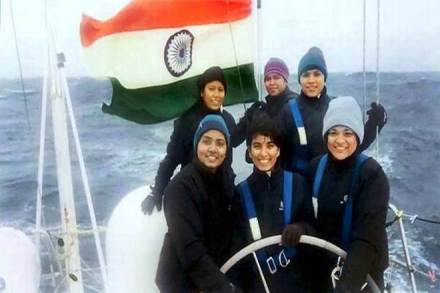The 6-member all women team of the Indian Navy who are onboard Indian Naval Ship (INS) Tarini crossed the Equator to enter the Northen hemisphere early this morning. The crew had departed from Port Louis in Mauritius on April 26th and is in its final leg of their maiden voyage to circumnavigate the globe. The official twitter account of the Indian Navy said that INS Tarini was just 1012 nautical miles away from Goa and is expected to arrive home in a few days. INS Tarini had stopped in Port Louis for an emergency, to rectify its steering gear. However, it was soon back on sail after the National Coast Guard of Mauritius provided speedy assistance to the crew members.
The crew which is led by Lt Commander Vartika Joshi left Goa on September 10th to circumnavigate the globe with four port calls in Fremantle in Australia, Lyttelton in New Zeland, Port Stanley in the Falkland Islands and Cape Town in South Africa. INS Tarini had entered Cape Town, the last port stop in its expedition on March 2nd, but had to also stop at Port Louis due to an emergency. The vessel has covered over 18,000 nautical miles from Goa and has entered the northern hemisphere again. The crew members were also seen celebrating the journey so far, by cutting a cake on onboard INS Tarini.
The all-women crew who started their journey of Navika Sagar Parikrama on a 55-foot yacht consists of Lt Commander Pratibha Jamwal, Lt Commander P Swati, Lt Vijaya Devi, Lt B Aishwarya and Lt Payal Gupta. The Navika Sagar Parikrama expedition comes in consonance of the national policy to empower women. The expedition also aims to showcase “Nari Shakti”, women power on an international platform. The crew had also met with the Prime Minister Narendra Modi in August 2017 and had explained to him the details of their voyage.
The first-ever Indian circumnavigation of the globe by the all-women crew is on a 55-foot yacht. The INSV Tarini is an indigenously built sailing vessel and was inducted in the Navy in 2017. The crew which was trained at the Ocean Sailing node was completely prepared before taking up the voyage. During their journey, the crew has extensively collected meteorological, ocean, wave and marine pollution data. The vessel also encountered rough seas, high stormy conditions and severely cold temperatures, making the expedition an extremely challenging one. The Indian Navy also said that the crew had to face strong winds of 60 knots and high waves of up to 7 metres. However, the expedition which has been successful so far is expected to end in mid-May.
